The British Library’s exhibition on Terror and Wonder: The Gothic Imagination continues until mid-January. Special Collections in UCC Library lent The Orphan of The Rhine by Eleanor Sleath (LE 100 SLEA v. 1 – 2) to the British Library and that has been described in a previous post. However Special Collections has much more Gothic fiction than its most famous inhabitant.
Where Gothic Began
Last year was the 250th anniversary of The Castle of Otranto: A Gothic Novel (1764) written by Horace Walpole. The copy in Special Collections is from 1886 but earlier editions of The Castle of Otranto are available through the database Eighteenth Century Collections Online (ECCO):
- Dublin: printed for Elizabeth Watts, 1765.
- Dublin: printed by J. Hoey, J. Exshaw, P. Wilson, S. Cotter, W. Sleater, J. Potts, S. Watson, and J. Hoey, junior, 1765.
- Dublin: printed by T. Henshall, No. 3, Bride-Street, [1790?].
Walpole was the forerunner of authors such as Charles Maturin, Regina Marie Roche, Bram Stoker, Edgar Allen Poe.
The Return of a ‘Horrid Novelist’
One of the ‘horrid novels’ mentioned in Jane Austen’s Northanger Abbey is Clermont by Regina Marie Roche. UCC Library has access to Clermont, through ECCO but within Special Collections is another of Regina Maria Roche’s Gothic novels The Children of the Abbey.
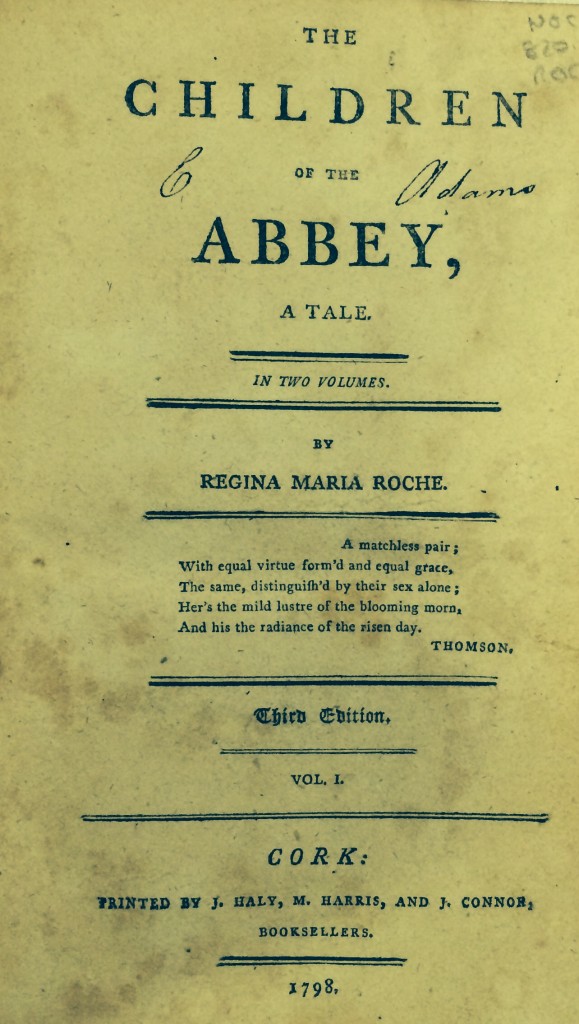
Regina Maria Roche was born in Waterford in 1764 to Captain Blundell Dalton of the 40th Regiment and she moved to England in 1794 after her marriage. Her first two novels were published under her maiden name (Dalton). Roche wrote sixteen novels, the majority of which were published by the Minerva Press and William Lane. She returned to Ireland in the 1820s. Both The Children of the Abbey and Clermont were published in several editions and were translated into French and Spanish. The Children of the Abbey is about the orphaned children of an Irish soldier who are fraudulently disinherited by a wicked aunt and cousin. There are supernatural surprises in their adventures in an Irish castle and the ‘haunted’ abbey of Dunreath. The Children of the Abbey was first published by Minerva Press in 1796. The Children of the Abbey (3rd ed) is also available in Special Collections from a Cork printing from 1798.
Some of Roche’s other works are available through GRAIL microfiche in Special Collections. These include: The Children of the Abbey (1796), The Castle Chapel (1825) and Contrast (1828). GRAIL (Galway Resource for Anglo-Irish Literature) reproduces over 500 works by 80 Anglo-Irish 19th century writers on microfiche. It is a treasure of 19th century popular fiction, drama, poetry, and even folksongs.
Frankenstein: or, The Modern Prometheus
One of the best known Gothic works is Mary Shelley’s Frankenstein (1818). Victor Frankenstein creates a grotesque creature in an unorthodox scientific experiment. The first edition was published anonymously in London in 1818. Shelley’s name appears on the second edition, published in France in 1823. Special Collections holds a facsimile edition of Mary Shelley’s manuscript novel, 1816-17 (with alterations in the hand of Percy Bysshe Shelley) as it survives in draft and fair copy deposited by Lord Abinger in the Bodleian Library, Oxford (Dep. c. 477/1 and Dep. c. 534/1-2). The edition publishes the extant portions of the 1816-1817 Draft and the 1817 Fair Copy manuscripts, and prints both in a parallel format that allows the reader to study 400 pages of manuscript photofacsimiles in Mary Shelley’s hand. There are editorial and collaborative emendations by MWS and Percy Bysshe Shelley and these can be compared with the first printed text.
Gothic Literature in Ireland
Charles Maturin (1782 – 1824) was born in Dublin and lived in Galway before returning to Dublin. Melmoth the Wanderer was inspired by one of Maturin’s own sermons in which he asked whether anyone, whatever their present sufferings, would choose prosperity in this life in return for certain damnation in the next. Melmoth the Wanderer is a series of interlinked tales featuring John Melmoth. Melmoth sells himself to the devil in return for 150 years of life and vigour, and can only be redeemed if he succeeds in persuading someone else to take up the bargain in his place. As with Roche’s work Melmoth the Wanderer was translated into numerous European languages and influenced writers such as Balzac and Baudelaire.
Joseph Sheridan Le Fanu (1814 – 1873) was also born in Dublin, lived in Limerick and was a writer of Gothic tales and mystery. One of his best known works is In A Glass Darkly (1872) which is a collection of five short stories in the horror and mystery genres presented as the posthumous papers of the occult detective Dr Martin Hesselius. Dr Hesselius was a model for Bram Stoker’s Van Helsing. The title is taken from Corinthians and is a deliberate misquotation of the passage “through a glass darkly.”
Melmoth the Wanderer and In A Glass Darkly are both available through GRAIL.
American Gothic
Edgar Allen Poe (1809 – 1849) was an American author and literary critic. He is best known for his tales of mystery and the macabre, as well as being a practitioner of the American short story and as the inventor of the detective fiction genre.
Edgar Allen Poe’s “The Fall of the House of Usher” is a key work in American Gothic. Every element and detail in the story is relevant. The presence of the crumbling house is reminiscent of the disintegrating castle in The Castle of Otranto. The Gothic is present in “The Fall of the House of Usher” in establishing the psychological relationship between character and place as well as through the inclusion of dreaming, doubles, madness and the shadow selves or other.
Charles Baudelaire who was influenced by Maturin was also interested in Poe. Baudelaire translated Poe’s Tales in the 1850s.
However the edition of Tales of Mystery and Imagination illustrated by Harry Clarke is possibly the best known. Harry Clarke (1889 – 1931) was born in Dublin and was an Irish stained-glass artist and book illustrator. In the first version of the Clarke edition of Tales of Mystery and Imagination the illustrations were restricted to halftone, while a second iteration with eight colour plates and more than 24 halftone images was published in 1923. This made his reputation as a book illustrator. Special Collection’s copy is one of the second iteration and is finely bound by The Chelsea Bindery in black morocco with titles and decoration to the spine. There are marbled end-papers and gilt edges.
Gothic Literature in Gaelic Irish
With the establishment of The Irish Free State in 1922 there was “a revival of the Irish language [which] was taken from the sole care of cultural pressure groups and placed firmly on the agenda of the independent Irish government” (Kelly 29). ‘An Gúm’ translates as ‘The Scheme’ and it was established as the publishing division of the Department of Education in 1925 by Ernest Blythe, the then Minister for Finance in the Irish Free State to ensure the supply of text books and reading matter which the policy of reviving the Irish language required. An Gúm did publish original writing in the Irish Gaelic language though translations into Irish Gaelic formed an important part of the project. These translations were mostly from English. By 1938 An Gúm had put forth 500 titles.
Wuthering Heights written by Emily Brontë was published in 1847. Catherine’s relationship with Heathcliff demonstrates the dynamics of the Gothic romance. Within the Cooke Collection is a copy of Wuthering Heights from 1901. Already it is part of the World’s Classics Series. Wuthering Heights was one of the novels chosen to be translated into Irish through An Gúm. Daniel Corkery, Prof. of English in UCC (1931 – 1947), holds two copies of the translation Árda Wuthering in his collection. Seán Ó Ciosáin is the translator of Wuthering Heights.
Another work translated as part of An Gúm was Bram Stoker’s Dracula. Bram Stoker (1847 – 1912) was born in Dublin and moved to London after his marriage in 1878. Dracula (1897) is not the first vampire novel but it is the best known. Reviews of Dracula on its first publication said that it was a classic of Gothic horror and should be compared with The Mysteries of Udolpho, Frankenstein and “The Fall of the House of Usher.” There was controversy regarding the publication of Dracula in America following Murnau’s film Nosferatu. Therefore it is notable that the Irish translation was published with the permission of Mrs. Bram Stoker.
While the dust-jacket for the Irish translation of Dracula is not present on the copy in Special Collections Niall McCormack discusses the importance of this dust-jacket on Hitone: Vintage Irish Book Covers.
To assist with research on the Gothic Special Collections has acquired a copy of Montague Summers’ A Gothic Bibliography which covers all Gothic works from 1728 – 1916.
References
Brontë, Emily. Árda Wuthering. Trans. Seán Ó Ciosáin. Dublin: Oifig Díolta Foillseacháin Rialtais, 1933.
Brontë, Emily. Wuthering Heights. (1847) World’s Classics Series. London: Grant Richards, 1901.
Kelly, Adrian. “Cultural Imperatives: The Irish Language Revival and the Educational System.” Joost Augusteijn, ed. Ireland in the 1930s: New Perspectives. Dublin: Four Courts P, 1999. 29 – 46.
Le Fanu, Joseph Sheridan. In A Glass Darkly [microform]. Dublin: European Micropublishing Services, 1987.
Maturin, Charles. Melmoth the Wanderer. Dublin: European Micropublishing Services, 1987.
McCormack, Niall. “Dracula: 1933 cover by Austin Molloy.” 21 Oct 2013. Hitone: Vintage Irish Book Covers. Accessed: 7 July 2014.
Poe, Edgar Allen. The Illustrated Edgar Allan Poe: A Selection of the Tales Together with a Poem. Ed. and introd. Roy Gasson. London: Jupiter Books, 1976.
Poe, Edgar Allen. Nouvelles histoires extraordinaires. Trad. Charles Baudelaire. Paris: Nelson, [1924?].
Poe, Edgar Allen. Tales of Mystery and Imagination. Illus. Harry Clarke. New York: Tudor Pub. Co., 1933.
Roche, Regina Maria. The Children of the Abbey. Cork: J. Haly, M. Harris, and J. Connor, 1798.
Roche, Regina Maria. Clermont. London: printed at the Minerva-Press, for William Lane, 1798.
Shelley, Mary Wollstonecraft. The Frankenstein Notebooks. Transcript. & comment. Charles E. Robinson. New York: Garland, 1996.
Stoker, Bram. Dracula. Trans. Seán Ó’Cuirrín. Baile Atha Cliath : Oifig Díolta Foilseacháin Rialtais, 1933.
Summers, Montague. A Gothic Bibliography. New York: Russell, 1964.
Walpole, Horace. The Castle of Otranto. London: Cassells, 1886.
Comments are closed.
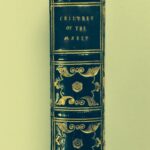

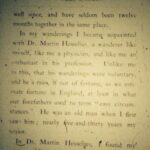
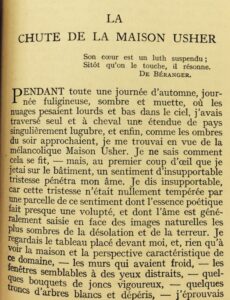
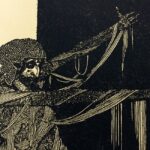
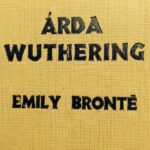
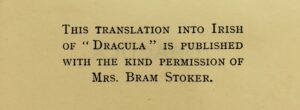

[…] you’re interested in Poe, Bram Stoker or Le Fanu consider All Things Gothic. If you’re interested in ‘The Dance of Death’ consider ‘La Danse […]